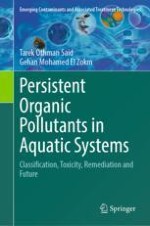2024 | OriginalPaper | Buchkapitel
2. Chemistry of POPs Referring to Scenarios and Forecasting the Effects of Global Change
verfasst von : Tarek Othman Said, Gehan Mohamed El Zokm
Erschienen in: Persistent Organic Pollutants in Aquatic Systems
Verlag: Springer Nature Switzerland
Aktivieren Sie unsere intelligente Suche, um passende Fachinhalte oder Patente zu finden.
Wählen Sie Textabschnitte aus um mit Künstlicher Intelligenz passenden Patente zu finden. powered by
Markieren Sie Textabschnitte, um KI-gestützt weitere passende Inhalte zu finden. powered by
